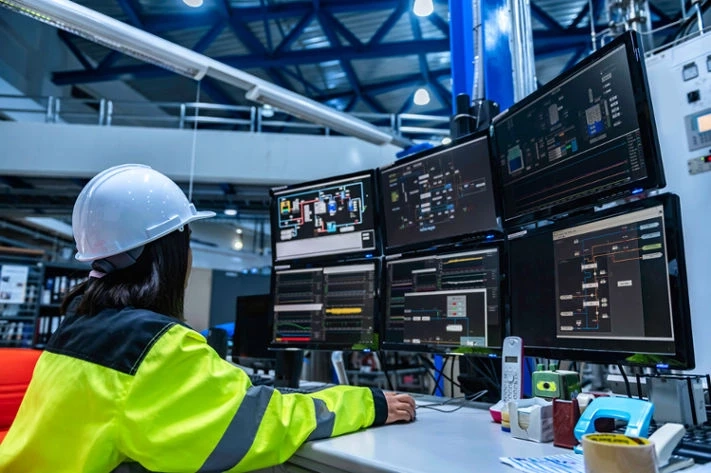New technologies and fashions in design are continually being introduced in the control room sector. Power plants, transportation, and process control are just a few examples of businesses that depend heavily on ongoing monitoring and oversight. They support the maintenance of safety, effectiveness, and productivity by giving operators the resources and knowledge they need to make wise decisions. The control room design has changed recently to incorporate collaborative workspaces, make use of substantial video walls, enhance ergonomics, and provide operators with a more pleasant and effective working environment. Here are a few of the most recent design trends for control rooms that can boost efficiency and performance.
DIGITAL TRANSFORMATION
Automation is replacing jobs in all sectors of the economy, and control rooms are not being left behind. Automating and digitising business processes through digital transformation can lower costs, boost productivity, and enhance safety. Additionally, there will be a considerable acceleration of digital transformation projects in control rooms, with a decrease in on-site manual operations and an increase in cloud-based data analytics. Automation technologies like machine learning (ML), artificial intelligence (AI), robotics, and natural language processing (NLP) are already being utilised to automate some operations that would otherwise require human participation, and this trend will only intensify over time.
COLLABORATIVE CONTROL ROOM ENVIRONMENT
The shift to collaborative workplaces is one of the biggest trends in control rooms. Multiple operators can cooperate in collaborative control rooms to better handle complicated procedures. This is accomplished by establishing a common area where operators may collaborate and communicate successfully. Large video walls are a common component in collaborative control rooms, enabling operators to view numerous sources of information at once, improving awareness of the situation and decision-making.
LED VIDEO WALLS
The use of LED display walls and video rooms in security operations centres is growing. Operators require larger displays to show the data since there is more data to analyse than before. An LED video wall has a number of benefits over monitor projections or a hybrid laser cube display wall.
LEDs don't require as much room as conventional projection technologies.Up to 8K resolution is possible with a single LED display screen.LEDs can achieve HD resolutions and higher when incorporated.Inexplicable designs, including curving walls, can be created by arranging and shaping LED cabinets in an effortless manner.LEDs work well in well-lit areas, so you may install them in spaces that have windows or other strong lighting sources.INDUSTRIAL INTERNET OF THINGS (IIOT)
The network of interconnected, intelligent industrial devices that produces systems that monitor and gather data as well as generate predictive and prescriptive analytics is known as the Industrial Internet of Things (IIoT). Utilities, network operations centres, and security operation centres are just a few of the industries where the IIoT has expanded. While this enables organisations to utilise even more real-time data, it can also provide difficulties, such as managing and distributing data from many source types. An expert integrator can help you overcome these obstacles. The IIoT's widespread adoption has highlighted the fact that control room technology is a quickly evolving industry. Designing a control room requires flexibility because it is both a long-term investment that must run dependably and a part of the ever-evolving technological landscape.
VIRTUAL AND AUGMENTED REALITY
In operation centres and control rooms, augmented reality (AR) and virtual reality (VR) are swiftly gaining popularity. They will be utilised to give operators an immersive experience so they can interact with data visualisations and emergency scenarios in a more authentic 3D setting. VR can be used to practise emergency procedures in advance, for instance, providing operators a chance to make mistakes in a secure setting. AR allows for the overlaying of data, such as guidelines or warnings, onto actual environments or objects for improved comprehension and visibility.
IMPROVED DATA VISUALISATION
Operators in the control room get a large amount of real-time data in various formats from many sources. Data by themselves, though, are insufficient. Strong data visualisation tools are required to make information more understandable for quicker group decision-making. The most recent solutions give users the ability to simultaneously visualise numerous data systems and information formats in order to show a full picture for evaluation and get around the drawbacks of isolated views. A better decision-making process depends on data visualisation. The newest tools offer significant capability, but they also need to be simple to use, reliable, and always available.
BIOPHILIA
Since a few years ago, the design idea of "biophilia," which aims to incorporate more natural aspects into built environments, has gained popularity in the commercial interior design industry. Even in control room settings, biophilia might start to become more noticeable. There are several ways to incorporate biophilia into a control room's design. A significant yet easy technique to create a more "natural" setting is through lighting. Since display wall technology has advanced, control rooms may now accept various lighting situations, including windows for natural light, while still preserving visibility of data on the video wall.
HUMAN-MACHINE INTERFACES (HMIs)
Computer systems called human-machine interfaces (HMIs) assist users in controlling and observing industrial operations. They swap out conventional switches and controls for digital ones, which facilitates interaction and adjustment of a control process. Operators can start and halt cycles, modify settings, and carry out other tasks using HMIs. One or more programmable logic controllers (PLCs) or remote terminal units (RTUs) are equipped with complicated logic that must be communicated with by the human operator using special software. The use of HMIs in control rooms is becoming more and more crucial. The ability for operators to interact with and monitor the control process more effectively is becoming increasingly important, as is the ability to add a useful layer of data analytics that can boost performance and safety.
CONCLUSION
Unique difficulties have been presented to operational employees as a result of exponential development and modifications in control room architecture. The capabilities required to function efficiently cannot be provided by traditional control room solutions. Operators of control rooms want a flexible, scalable, and interoperable solution that builds a centralised dashboard to rapidly and efficiently visualise data to enhance situational awareness and enable group decision-making.



